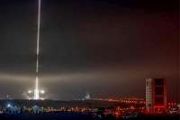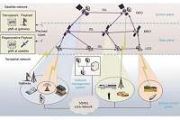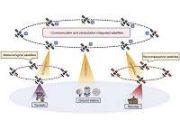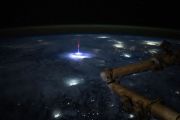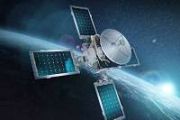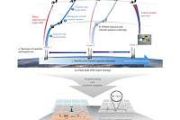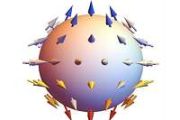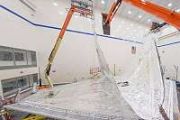
Copernical Team
Dragonfly Aerospace partners with LatConnect 60 for advanced SWIR imaging satellites
 Dragonfly Aerospace has announced a partnership with Australian Earth observation company LatConnect 60 to supply three Chameleon SWIR (shortwave infrared) imagers for their SWIRSAT satellites. Supported by the Australian Space Agency and the Western Australian State Government, the SWIRSAT satellite project aims to enhance Earth observation capabilities, with the satellites set for a 2026 launc
Dragonfly Aerospace has announced a partnership with Australian Earth observation company LatConnect 60 to supply three Chameleon SWIR (shortwave infrared) imagers for their SWIRSAT satellites. Supported by the Australian Space Agency and the Western Australian State Government, the SWIRSAT satellite project aims to enhance Earth observation capabilities, with the satellites set for a 2026 launc NASA grant awarded to enhance AI-driven satellite weather forecasting
 A research initiative led by the Penn State College of Information Sciences and Technology (IST) has secured a two-year, $1.23 million grant from NASA to enhance atmospheric and oceanic forecasting. The project aims to integrate artificial intelligence (AI) and satellite data into existing forecasting systems, potentially transforming how weather predictions are made.
"Typically, forecasts
A research initiative led by the Penn State College of Information Sciences and Technology (IST) has secured a two-year, $1.23 million grant from NASA to enhance atmospheric and oceanic forecasting. The project aims to integrate artificial intelligence (AI) and satellite data into existing forecasting systems, potentially transforming how weather predictions are made.
"Typically, forecasts Physicists measure quantum geometry for the first time
 MIT physicists and colleagues have for the first time measured the geometry, or shape, of electrons in solids at the quantum level. Scientists have long known how to measure the energies and velocities of electrons in crystalline materials, but until now, those systems' quantum geometry could only be inferred theoretically, or sometimes not at all.
The work, reported in the Nov. 25 issue o
MIT physicists and colleagues have for the first time measured the geometry, or shape, of electrons in solids at the quantum level. Scientists have long known how to measure the energies and velocities of electrons in crystalline materials, but until now, those systems' quantum geometry could only be inferred theoretically, or sometimes not at all.
The work, reported in the Nov. 25 issue o Pixxel kickstarts Firefly constellation for climate action
 Pixxel, a California-based company specializing in advanced space technology, has launched the first three satellites of its Firefly constellation as part of the Transporter-12 rideshare mission by SpaceX from Vandenberg Space Force Base in California. These satellites, integrated with the assistance of Exolaunch, mark the beginning of Pixxel's commercial operations, aimed at providing critical
Pixxel, a California-based company specializing in advanced space technology, has launched the first three satellites of its Firefly constellation as part of the Transporter-12 rideshare mission by SpaceX from Vandenberg Space Force Base in California. These satellites, integrated with the assistance of Exolaunch, mark the beginning of Pixxel's commercial operations, aimed at providing critical Research Shows Impact of 'Super-Earth' on Solar System
 Emily Simpson '24 has loved space since she was a 10-year-old kid celebrating her birthday at a planetarium. Now a recent Florida Tech graduate, she leaves with not only a dual degree in planetary science and astronomy and astrophysics but with published research, too.
Emily Simpson '24 has loved space since she was a 10-year-old kid celebrating her birthday at a planetarium. Now a recent Florida Tech graduate, she leaves with not only a dual degree in planetary science and astronomy and astrophysics but with published research, too. SpaceX set for seventh test of Starship megarocket
 Elon Musk's SpaceX is gearing up for the seventh orbital flight test of Starship, the colossal prototype rocket the company hopes will help humans colonize Mars.
A launch window from the company's Starbase in Boca Chica, Texas, opens at 4:00 pm (2200 GMT) Wednesday and will be carried in a live webcast on Musk's X platform.
Space enthusiasts will be eager to see if SpaceX can replicate t
Elon Musk's SpaceX is gearing up for the seventh orbital flight test of Starship, the colossal prototype rocket the company hopes will help humans colonize Mars.
A launch window from the company's Starbase in Boca Chica, Texas, opens at 4:00 pm (2200 GMT) Wednesday and will be carried in a live webcast on Musk's X platform.
Space enthusiasts will be eager to see if SpaceX can replicate t Private US, Japanese lunar landers launch on single rocket
 One rocket, two missions: lunar landers built by US and Japanese companies launched their "rideshare" to the Moon on Wednesday, showcasing the private sector's growing role in space exploration.
On board the SpaceX Falcon 9 rocket that took off from the Kennedy Space Center in Florida were Firefly Aerospace's Blue Ghost and ispace's Resilience from Japan, which will also deploy a micro rover
One rocket, two missions: lunar landers built by US and Japanese companies launched their "rideshare" to the Moon on Wednesday, showcasing the private sector's growing role in space exploration.
On board the SpaceX Falcon 9 rocket that took off from the Kennedy Space Center in Florida were Firefly Aerospace's Blue Ghost and ispace's Resilience from Japan, which will also deploy a micro rover IRIDE pathfinder satellite has launched

The first IRIDE satellite – the Pathfinder Hawk – is now in orbit around Earth after lifting off on a SpaceX Falcon 9 rocket from the Vandenberg Space Force Base in California on 14 January.
As its ‘Pathfinder’ name suggests, this new microsatellite is a prototype for one of the six IRIDE constellations, which are tailored to provide information for a wide range of environmental, emergency and security services for Italy.
Tech innovation propels China's commercial space industry growth
 China's commercial space industry made remarkable progress in 2024, with market projections suggesting it will exceed 2.3 trillion yuan (approximately 314 billion U.S. dollars) in value.
Technological advancements in key areas, such as reusable rocket development, smart launch infrastructure, and cutting-edge satellite transmission technologies, have catalyzed rapid industry growth and pro
China's commercial space industry made remarkable progress in 2024, with market projections suggesting it will exceed 2.3 trillion yuan (approximately 314 billion U.S. dollars) in value.
Technological advancements in key areas, such as reusable rocket development, smart launch infrastructure, and cutting-edge satellite transmission technologies, have catalyzed rapid industry growth and pro Gilat receives new orders for satellite amplifiers supporting LEO constellations
 Gilat Satellite Networks Ltd. (Nasdaq: GILT, TASE: GILT) has announced securing orders exceeding $3 million from leading service providers for its Gateway Solid State Power Amplifiers (SSPAs). These systems are designed to support Low Earth Orbit (LEO) satellite constellations and are scheduled for delivery over the next 12 months.
LEO satellite constellations are becoming an integral part
Gilat Satellite Networks Ltd. (Nasdaq: GILT, TASE: GILT) has announced securing orders exceeding $3 million from leading service providers for its Gateway Solid State Power Amplifiers (SSPAs). These systems are designed to support Low Earth Orbit (LEO) satellite constellations and are scheduled for delivery over the next 12 months.
LEO satellite constellations are becoming an integral part 
